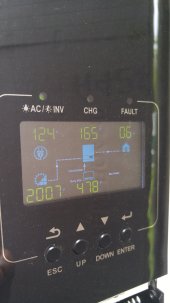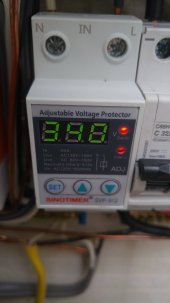I've finally been able to get a
battery. I did a lot of testing. I am pretty disappointed with this device.
1. The utility draw disappeared when I connected the battery, however, the battery is getting drained at 0.7 amps AFTER it is discharged below the 'back to utility' voltage. I have it set up to discharge battery first, then use utility. The battery normally discharges at ~10A to 20% state of charge (44.8V) by 5 AM in the morning and switches to utility. However, after the switch, the inverter is still draining the battery at 0.7A, even with it being in the utility mode. Ian from watts247.com got back to me regarding this issue. Growatt engineers told him that when the inverter is connected to the battery, 'the battery will power the LCD, beeper, etc.' So, there isn't any way to solve this flaw.
2. Once the b2ac voltage setting is reached and inverter switches to utility mode, utility continues to be used (even after the sun comes up) to power the load until ac2b battery voltage setting is reached. This can be manually worked around by switching utility input off and back on when there is enough solar to power the load.
3. When the battery is discharged to 'switch to utility' voltage and the inverter switches to the utility, after some time the AC charger kicks in and starts charging the battery, even with battery charge priority set to 'PV Only'. This is another design flaw. I specifically set it to NOT charge from utility. Also, once I kill the utility breaker and reset it, it starts behaving properly again (by not charging the battery). If I turn everything off, disconnect and reconnect the utility and the battery, it starts charging from utility immediately, even though I specifically selected to charge the battery only from solar.
4. The back to battery voltage setting range is not usable. It starts at 48V. I wish I could go lower. My battery range is 40V - 51V. I would like to go lower than 48V for back to battery voltage setting.
5. The whole b2ac/ac2b mode switching combined with too high back to battery voltage setting and phantom utility charging is causing utility to be used when it wouldn't strictly be necessary. This creates a lot of inefficiency. The only solution I can see is to have big enough battery bank to never need utility, which makes the whole utility feature pretty useless. Ian from watts247.com suggested setting utility charging current to 1A, which mitigates the problem somewhat but it is not an acceptable solution.
6. PVkeeper software sucks:
- crashes all the time
- version 2.0 doesn't show battery discharge current
- there is no temperature display, it only shows up in logs
- password feature is useless and annoying
- there is no manual b2ac/ac2b switching in the software, I wish I had that option
- 'PV Charge Current' value in the software is incorrect, shows 3x true value
7. Battery state of charge indicator is incorrect.
8. b2ac/ac2b switching is not seamless. My UPS that I have connected as load cuts out, sometimes in and out multiple times in a few seconds, when the inverter is doing the switching.
9. The inverter voltage and current readings are off. I am going to attempt calibration sometime to see if I can solve this issue.
10. Some lights connected to the output of the inverter flicker intermittently when the battery is charging with solar. It doesn't happen with all light bulbs. My fridge's compressor makes a slightly different noise when the flickering happens. It does not occur in utility mode or when the battery is discharging. Ian from watts247.com had said that this is related to reactive loads feedback. He recommended using some inline appliance filtering or by adding some resistive loads. I am not sure if I buy that explanation due to the fact that the flickering is only happening during battery charging.
I would appreciate any ideas and recommendations. Thanks.




